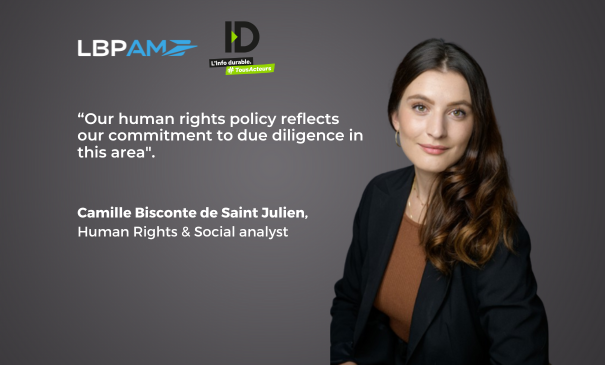Taking human rights into account in the asset management sector: the example of LBP AM
Link

Social SRI analyst Camille Bisconte de Saint Julien answered questions from Info Durable (ID) on LBP AM and Tocqueville Finance's human rights policy. It was an opportunity for her to share our investment strategy and the issues at stake for issuers and investors alike.
"The notion of human rights encompasses all the inalienable rights universally recognized to all people, whatever their personal characteristics," explains Camille Bisconte de Saint Julien. Today, the United Nations Guiding Principles on Business and Human Rights, adopted in 2021, offer an international reference standard. Companies are therefore expected to formalize their human rights commitments in a clear and transparent manner, identify and assess the human rights risks they may face, and implement prevention, mitigation and remediation measures.
"Our approach is based on shareholder engagement with companies".
As an asset management company, how do you approach the issue of human rights?
We have just finalized our human rights policy, which embodies our commitment to due diligence in this area. As investors, our impact is mainly linked to the activities of the companies in which we invest.
We have drawn up a risk map by sector, which enables us to assess two aspects: high-risk sectors requiring particular attention, and salient human rights issues within each sector. We also pay close attention to the risks associated with the countries in which these companies operate, with certain zones requiring heightened vigilance.
On the "mitigation and prevention" front, we have several levers at our disposal. Our proprietary extra-financial analysis model "GREaT ̶ for Governance, Resources, Environment and Territories ̶ specifically addresses the issue of human rights through the "Territories" and "Resources" pillars. For example, the former addresses responsible practices with suppliers and in supply chains, while the latter contains criteria related to employees' fundamental rights.
Another key pillar of our approach is shareholder engagement with companies, to encourage them to strengthen their human rights practices or remedy any potential negative impacts they may have caused or contributed to. This necessarily involves a healthy dialogue, which can take place in the event of a serious risk of impact on human rights or a major controversy, or because the company belongs to a sector identified as particularly at risk. Or where there is a discrepancy between the company's practices and transparency, and the risks it may face.
Is exclusion also a lever?
Absolutely. As part of our normative exclusion policy, we can exclude any issuer for which there is an unacceptable risk that it is causing or contributing to particularly serious human rights violations. There are two ways of identifying this risk: quantitatively, using controversy data, or qualitatively, using analysts who continuously monitor human rights issues. The final decision must aim, as far as possible, to reduce and mitigate the risk of future violations of the standards. Therefore, when we decide to exclude a company, it means that we consider that we have exhausted all options for reducing this impact.
Could you tell us about the LBPAM SRI Human Rights SICAV, created in partnership with the International Federation for Human Rights (FIDH)?
This is a diversified fund invested in corporate and government bonds, as well as equities. The investment approach aims to promote compliance with internationally recognized human rights standards, and the implementation of robust due diligence by companies. This strategy is based on an analysis carried out jointly with the FIDH, which aims to select the companies and countries with the best human rights practices.
Read the full interview on the Info Durable website, in French only.